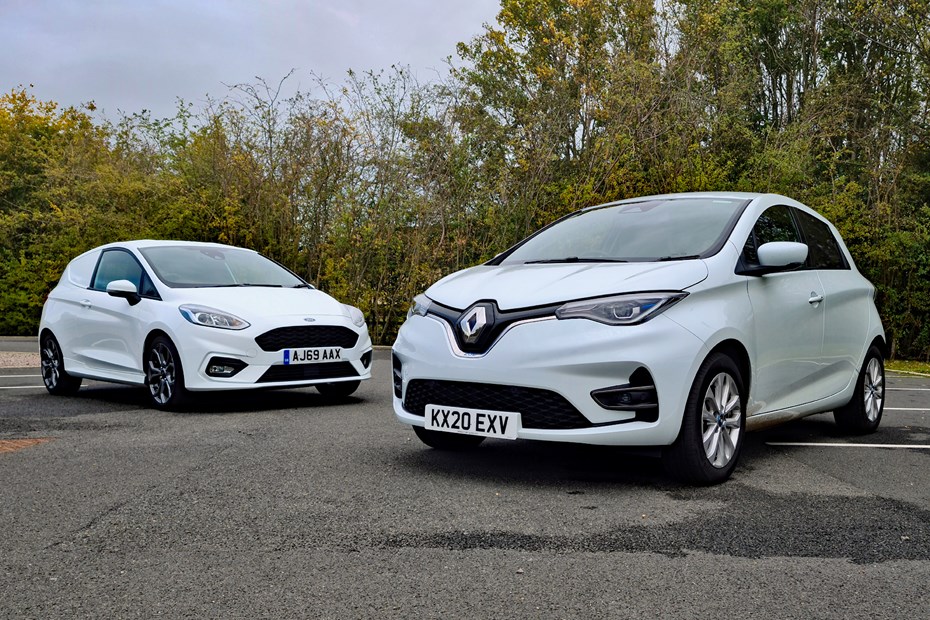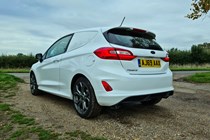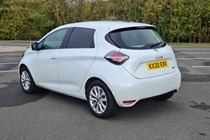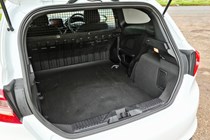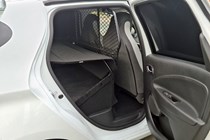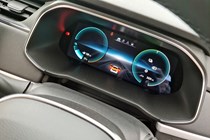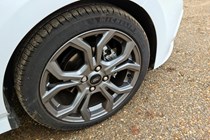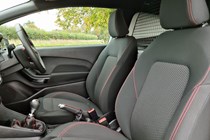There are now two car-derived van (CDV) models on sale in the UK, which is one more than at the start of 2020. So it’s a small market, making it even more interesting that the two CDVs in questions – the Ford Fiesta Van and the Renault Zoe Van – are rather different while also having one surprising thing in common.
They both reject diesel, the traditional fuel of choice for van drivers.
The Fiesta Van remains reasonably conventional in spite of this; it comes with a choice of petrol engines instead – including a top-spec version that includes a mild-hybrid system. The Zoe Van, however, is based on Renault’s pure-electric car. Which means if you need your van for long-distance journeys you probably already have a winner here.
That’s a little unfair – with a claimed 245-mile WLTP driving range, the Zoe Van goes further per charge than any other electric van on sale. But even with rapid charging capability, that’s still less convenient than a petrol-powered Fiesta Van with a theoretical WLTP driving range of 580 miles per tank that can be refilled in moments at any petrol station.
Putting this point aside for the time being, we’ve got the Renault Zoe Van and the Ford Fiesta Sport Van together to see whether there are any further major reasons you should choose one over the other.
The same but different
As you can see from the pictures, if you ignore what’s under the bonnet, these two vans appear to be very similar. They’re both based on supermini-size cars, and take up about the same amount of space on the road; the Renault is slightly larger, but there are only a few millimetres in it in every direction.

The conversion from car to van follows a logical pattern, too. The rear seats are removed, and in their place is fitted a flat load floor, with a part-mesh bulkhead between the load space and the remaining front seats. Sat in those front seats, everything about these vans is identical to the cars they’re based on.
The three-door Fiesta looks a little more van-like, with a body-coloured panel in place of the rear side windows. The Zoe is a five-door car, which does mean you are able to access the load-space through the side doors, with glass replaced by black blanking panels.
Which is more practical?
The Ford’s load space is nearly 8cm longer and as much as 17cm wider – but those are at its maximum dimensions. According to the official measurements, the Zoe Van has a marginally larger overall load volume of 1.0 cu m (cubic metre) to the Fiesta Van’s 0.96 cu m, thanks in part to the less sloped angle of the Renault’s roof.
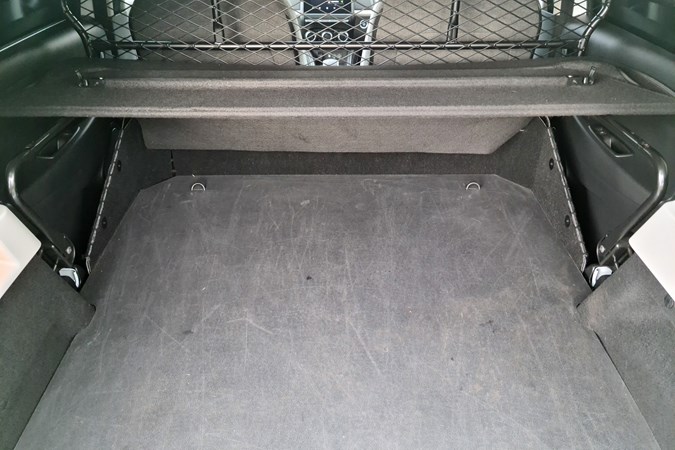
That’s only part of the story. While the Zoe Van has a rather neat fitted load cover that can protect items in the back from prying eyes (assuming they fit under its 41cm height), only the Fiesta Van has a fully metal bulkhead. Though both have metal mesh upper portions, the lower section of the Renault’s is made from some kind of tough composite material rather than the steel Ford uses.
How important that is to you may depend on the amount of weight you’re expecting to carry in the back. And since the Zoe Van has a particularly limited 368kg payload rating, maybe it isn’t very much. The Fiesta Sport Van we’re testing here can carry 508kg.

Seems unlikely you’ll be wanting to tow anything with a van of this size, but if you do your only choice is the Fiesta; with the 125hp petrol engine fitted the max is 1,100kg for a braked trailer, 590kg for an unbraked trailer. The Zoe Van isn’t rated to tow anything at all.
What are they like inside?
Up front both of these vans are exactly the same as the cars they are based on. In the Zoe’s case, this means a big central touchscreen infotainment system and a digital display instead of conventional dials. In other words, it’s very modern.
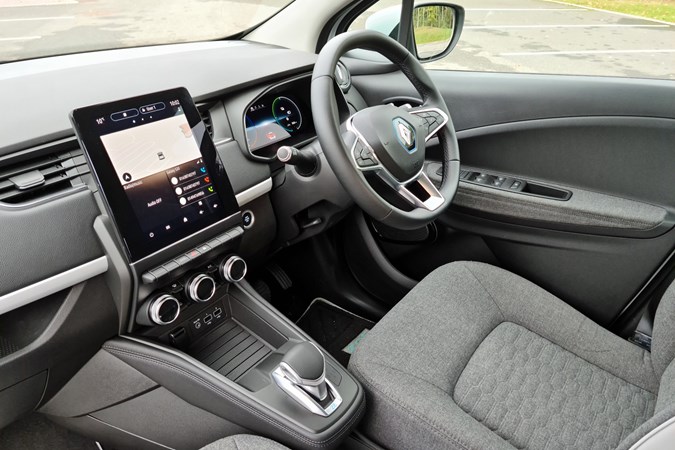
It’s also nicely put together, the infotainment (which includes Apple CarPlay and Android Auto) is reasonably logical and there are plenty of other nice touches, such as the air-conditioning controls, which are good looking and good to use.
There are two Zoe Van trim levels – Business and Business+ – and both come with heaps of standard equipment, including LED headlights, air-con, keyless go, cruise control and an alarm. Though you’ll want Business+ if built-in sat-nav, 16-inch alloy wheels and rear parking sensors are important, especially as the upgrade isn’t especially expensive.
While the Fiesta is more traditional inside – you get a central touchscreen but no digital dials – it is still smart, well made and packed with standard equipment. This is particularly the case for the Sport Van version, which is now the only model available to retail customers (the standard Fiesta Van can only be bought by large fleets).
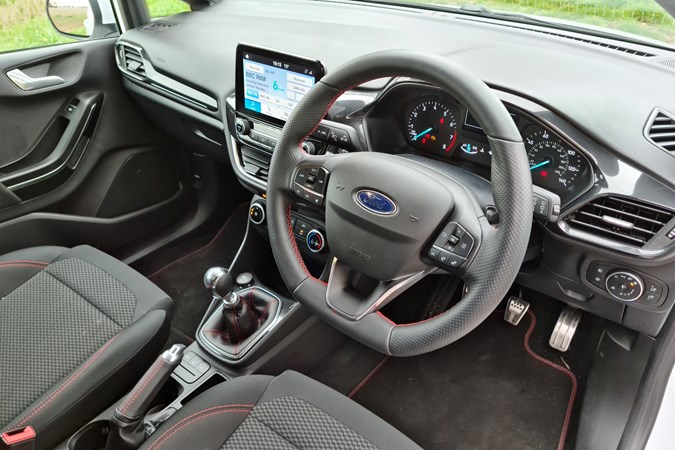
The Fiesta Sport Van not only benefits from a more powerful engine and an exterior look that echoes the Fiesta ST hot hatch, it also gets sporty seats and lots of red stitching throughout the interior, which successfully lifts the design above the ordinary.
Other standard items include black headlining, sports pedals, aluminium gearknob, Quickclear heated windscreen, keyless start, alarm, air-con, LED headlights and 17-inch alloy wheels. Not to mention sports suspension and disc brakes at the rear as well as the front.
The seating position in the Zoe Van is quite high – there are batteries underneath – but it’s easy enough to find an otherwise comfortable driving position in both models.
You can see pictures of all these details and more in the gallery at the top of this page.
Which is better to drive?
This will partly come down to your priorities, but neither of them is a chore from behind the wheel. Both are front-wheel drive, and both feel unsurprisingly car-like.
As an electric vehicle, the Zoe Van is particularly quiet, although at speed you’ll notice some road and wind noise. The electric motor is equivalent to 107hp, so it’s not slow either – especially as the 225Nm of torque it also offers is delivered as soon as you press the accelerator. And since it uses a single-speed transmission, responses are very snappy.
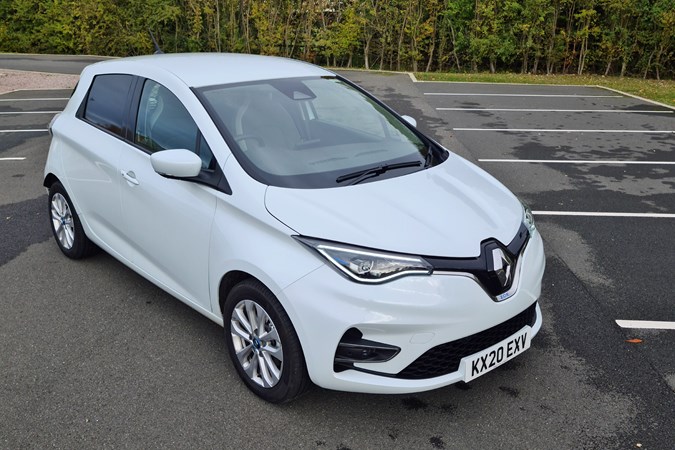
Around town it’s certainly nippy, and it’s happy enough at motorway speeds, too. But the suspension feels a little leaden and the steering is pretty lifeless, meaning that although it doesn’t roll around very much in the corners it’s more clinically efficient than anything like fun.
The Fiesta Van is quite the contrast in this respect. The Sport model is powered by a 125hp EcoBoost 1.0-litre three-cylinder turbo petrol, which is keen to see you make the most of its 170Nm of torque – a process that’s aided by a friendly six-speed manual gearbox.
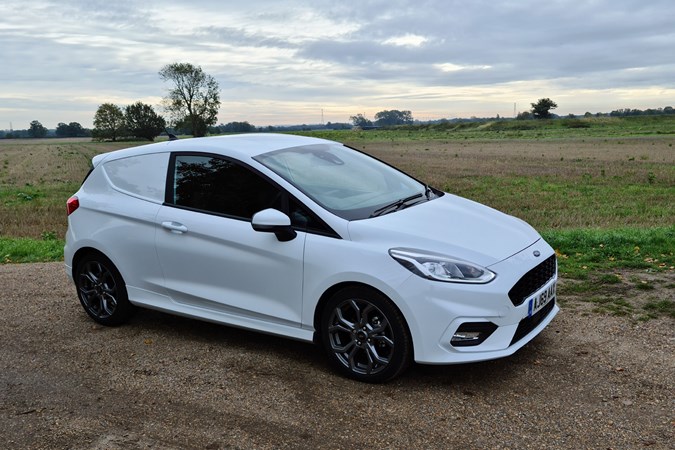
The power delivery is a little lumpy – like custard that hasn’t been properly stirred you occasionally get a bit more than you bargained for – and the ride is certainly firm. But the pay-off is fun. The Fiesta Van has sharp steering, quick reflexes and keeps body roll firmly in check.
It’s a much more involving vehicle to drive, though you don’t get the Zoe’s instant torque and nor can the petrol engine match the electric motor’s quietness at speed – not that either of them are particularly noisy at speed. The single-speed gearbox makes the Zoe a breeze in traffic.
So, back to the issue of driving range – does it matter?
The average daily mileage of a van is well under 100 miles, and the Zoe Van is officially rated to 245 miles per charge. For a lot of businesses there is probably no reason why the Renault couldn’t be deployed.
However, car-derived vans like these are often used by engineers, and those with specialist skills may be required to travel extensive distances – at which point the Zoe Van could become more difficult to manage. Not impossible, just… more difficult. Especially as we’ve found the driving range can fall away quite dramatically when travelling faster for long periods.
Which is cheaper to run?
The Renault’s running costs should prove far, far lower than the Ford’s, which is realistically unlikely to return much better than 40mpg in loaded use – probably less if you get carried away with the fun driving experience.
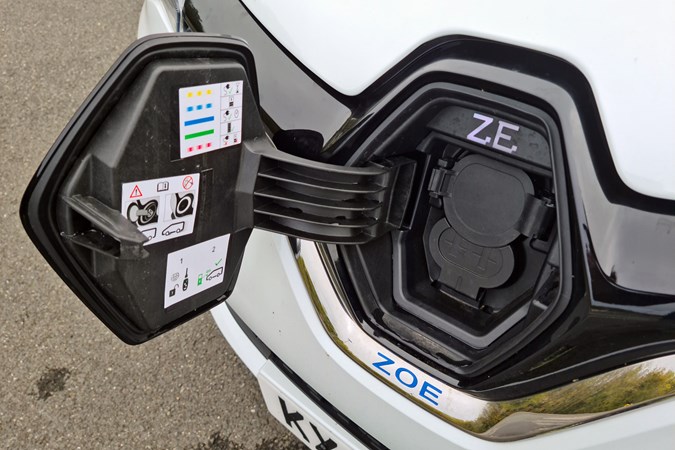
Consider the incredibly low cost-per-mile potential of driving on electric, and your fuel bills could plummet with the Zoe. Servicing should be substantially cheaper too, as there are no fluids to change and items such as brakes will last longer.
And though the Zoe Van is more expensive to buy outright, the UK government Plug-in Van Grant (PiVG) cuts the difference back by a considerable amount, and Renault gives you a Wallbox charger as part of the package.
What’s more, according to the current business contract hire costs from each manufacturer, the Zoe Van works out cheaper per month than the Fiesta Sport Van.

At the time of writing, over identical 36-month and 10,000 miles per year contract terms, even a top spec Zoe Van Business+ with Rapid Charging capability costs only £219 per month with a £1,314 advance payment, whereas the Fiesta Sport Van is £246 per month with a £1,473 initial payment. (All prices exclude VAT.)
So going electric could be far cheaper than you thought.
Ford Fiesta Van vs Renault Zoe Van – the verdict
In many respects, both head and heart say you should go for the Ford. The Fiesta Sport Van is good looking, well put together, fun to drive, has a higher payload rating and is not hamstrung by driving range or charging issues. The petrol engine even gives you a little bit of futureproofing against diesel bans in city centres, should they become a widespread thing.
However, if you don’t need hassle-free long-distance capability, nor a particularly high payload rating, the Renault has a lot going for it. The Zoe Van is available for less money per month, has way lower running costs and gives your business an instant green image makeover thanks to its zero emissions electric drive. Which brings even greater futureproofing against ultra-low emissions zones.
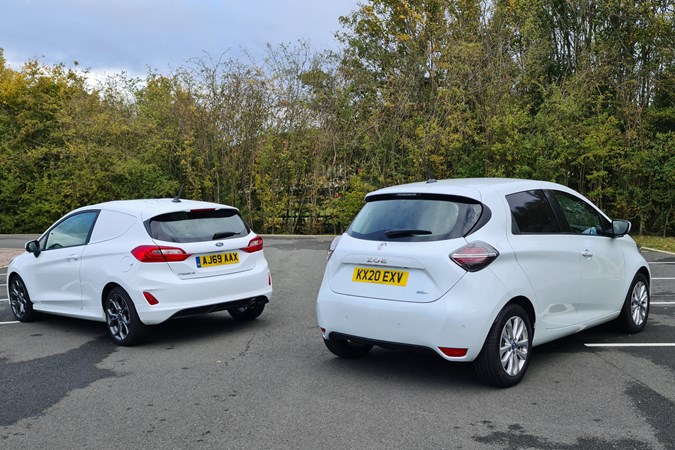
While it may not be quite as engaging, the Zoe Van is quiet and easy to drive, which helps take out a lot of the stress of buzzing around in traffic. We like the load cover for the back, too.
A tough decision, then. Ultimately, the Fiesta Van will continue to make more sense to more businesses at this point in time. But we strongly feel that if a Zoe Van could work for you then it’s the car-derived van you should be seriously considering.
Also read:
>> Van industry reacts to 2030 diesel and petrol new vehicle sales ban
>> Our main Ford Fiesta Van review
>> Our main Renault Zoe Van review
>> The Parkers Guide to electric vans
>> The best electric vans you can buy now
Just so you know, we may receive a commission or other compensation from the links on this website - read why you should trust us.


